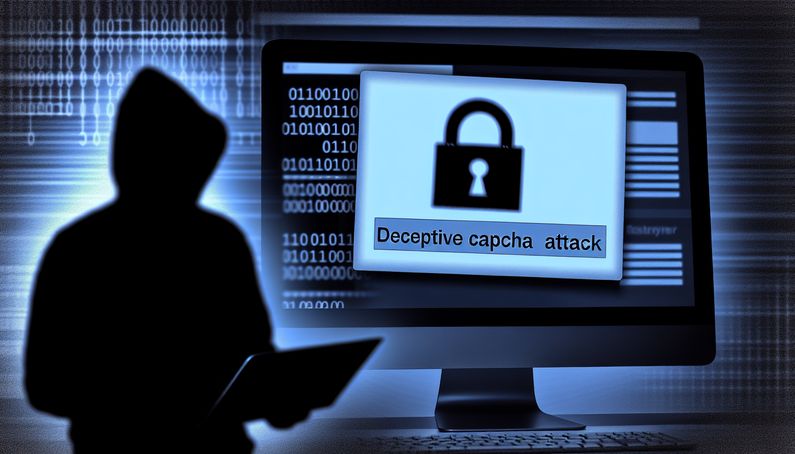
The ClickFix Attack: Unmasking the Fake CAPTCHA Deception
The ClickFix attack represents a cunning evolution in social engineering tactics, exploiting the trust users place in CAPTCHA systems. Unlike traditional CAPTCHAs, which are designed to distinguish humans from bots, the ClickFix attack uses a fake CAPTCHA to trick users into executing malicious scripts. This method was notably employed in the iClicker hack, where students and instructors were deceived into installing malware on their devices. By mimicking legitimate security processes, attackers manipulate users into unwittingly compromising their systems, highlighting the critical need for increased cybersecurity awareness and education.
The ClickFix Attack: Unmasking the Fake CAPTCHA Deception
Anatomy of the ClickFix Attack
The ClickFix attack is a sophisticated form of social engineering that exploits the familiarity and trust users have with CAPTCHA verification processes. Unlike traditional CAPTCHAs designed to differentiate between humans and bots, the ClickFix attack uses a fake CAPTCHA prompt to deceive users into executing malicious scripts. This attack was notably used in the iClicker hack, where students and instructors were tricked into installing malware on their devices.
The process begins with a user visiting a compromised website, where they are presented with a CAPTCHA-like prompt. This prompt instructs users to click a button labeled “I’m not a robot,” which is a familiar action for most internet users. However, clicking this button triggers a series of instructions that lead to the execution of a malicious PowerShell script. For those unfamiliar, a PowerShell script is a set of commands used to automate tasks on Windows systems. The user is guided to open the Windows Run dialog, paste the script, and execute it, unknowingly installing malware on their system.
The Role of Social Engineering
Social engineering is at the heart of the ClickFix attack. By mimicking legitimate CAPTCHA processes, attackers exploit users’ trust and familiarity with these security measures. The attack leverages the appearance of authenticity to manipulate users into unwittingly executing malicious commands. This method is particularly effective because it preys on human behavior, exploiting the tendency to comply with seemingly routine online interactions.
The attackers’ use of a fake CAPTCHA is a clever tactic that capitalizes on users’ expectations of security and verification processes. By presenting a familiar interface, the attackers increase the likelihood of user compliance, making it easier to deploy malware. This approach highlights the importance of user education and awareness in combating social engineering attacks.
Technical Execution of the Attack
The technical execution of the ClickFix attack involves the use of obfuscated PowerShell scripts. When a user follows the instructions provided by the fake CAPTCHA, a PowerShell script is silently copied into the Windows clipboard. This script is designed to connect to a remote server and retrieve additional malicious payloads. The obfuscation of the script makes it difficult for antivirus software to detect and block the attack.
Once executed, the script can download various types of malware, including infostealers and remote access trojans (RATs). These malicious programs can steal sensitive information such as passwords, cookies, and browsing history from web browsers. In some cases, the malware can also steal cryptocurrency wallets and private keys, posing a significant threat to users’ financial security.
Impact on Educational Institutions
The ClickFix attack has had a significant impact on educational institutions, particularly those using the iClicker platform. iClicker, a subsidiary of Macmillan, is widely used by instructors and students across the United States for classroom engagement and attendance tracking. The University of Michigan’s Safe Computing team issued a security alert warning users of the attack, which occurred between April 12 and April 16, 2025.
The attack targeted students and instructors, potentially compromising their devices and stealing credentials. This could lead to further attacks on college networks, resulting in widescale breaches and ransomware attacks. The incident underscores the vulnerability of educational institutions to cyberattacks and the need for robust security measures to protect sensitive data.
Preventative Measures and Recommendations
To mitigate the risk of ClickFix attacks and similar threats, several preventative measures and recommendations can be implemented:
- Exercise Caution: Users should be cautious when encountering CAPTCHA prompts and verify the authenticity of websites before entering sensitive information.
- Use Security Software: Regularly update security software to protect against malware infections.
- Cybersecurity Training: Organizations, particularly educational institutions, should prioritize cybersecurity awareness and training for their staff and students.
- Multi-Factor Authentication: Implementing multi-factor authentication and using password managers can enhance security by protecting user credentials.
- Regular Security Audits: Conduct regular security audits and vulnerability assessments to identify and address potential weaknesses in systems.
By staying informed about the latest threats and security best practices, institutions can better protect themselves against cyberattacks.
Final Thoughts
The ClickFix attack underscores the evolving nature of cyber threats and the importance of vigilance in digital interactions. By exploiting familiar security processes, attackers can easily manipulate users into executing harmful actions. This case study on the iClicker hack serves as a stark reminder of the vulnerabilities inherent in educational institutions and the necessity for robust security measures. As cyber threats continue to advance, so too must our strategies for defense, emphasizing user education and proactive security practices.
References
- iClicker hack targeted students with malware via fake CAPTCHA. (2025, April 17). Bleeping Computer. https://www.bleepingcomputer.com/news/security/iclicker-hack-targeted-students-with-malware-via-fake-captcha/



